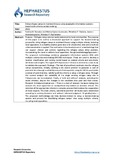| dc.contributor.author | Denekos, Sotirios N. | |
| dc.contributor.author | Koutsoukis, Nikitas-Spiros | |
| dc.contributor.author | Fakiolas, Efstathios T. | |
| dc.contributor.author | Konstantopoulos, Ioannis | |
| dc.contributor.author | Rachaniotis, Nikolaos P. | |
| dc.date.accessioned | 2022-01-26T10:35:10Z | |
| dc.date.available | 2022-01-26T10:35:10Z | |
| dc.date.issued | 2021-02-24 | |
| dc.identifier.issn | 2042-6747 | |
| dc.identifier.uri | http://hdl.handle.net/11728/12134 | |
| dc.description.abstract | Purpose – Refugee camps are not easily welcomed by local communities. The purpose of this paper is to outline a structured approach to support the decision-making process for siting refugee camps in mainland Greece using multiple criteria, including local opposition. A suitability analysis generates a list of potential sites and a multiple criteria evaluation is applied. The motivation is the development of a methodology that can support choices and policies regarding the refugee camps siting problem, incorporating the need to address local opposition.
Design/methodology/approach – The proposed methodology combines geographic information systems (GIS) with multiple criteria decision-making (MCDM) techniques. These are used to develop a location classification and ranking model based on related criteria and subcriteria, attributes and weights. The region of Peloponnese in Greece is selected as a case study to validate the approach.
Findings – The lack of predefined candidate sites for refugee camps necessitates, initially, tackling a site search problem to generate a pool of potential sites through a suitability analysis. Subsequently, using the GIS the pool yields a subset of potential sites, satisfying all the criteria to setup a refugee camp. Through the current analysis the suitability of the single existing refugee camp site in Peloponnese can be evaluated. Finally, a “with and without” analysis, excluding the social criterion, depicts the changes in the candidate sites pool and their scores.
Research limitations/implications – There is a lack of relevant literature taking into account the local opposition or sociopolitical implications as decision criteria. The selection of the appropriate criteria is a complex process that involves the cooperation of many experts. The main criteria, subcriteria and their attributes were determined according to existing literature and authors’ informed judgment.
Originality/value – The proposed methodology can help decision-makers to setup a decision-making system and process for identifying refugee camps’ sites using multiple criteria, including local opposition. | en_UK |
| dc.language.iso | en | en_UK |
| dc.publisher | Emerald Publishing Limited | en_UK |
| dc.relation.ispartofseries | Journal of Humanitarian Logistics and Supply Chain Management;Vol. 11 No. 3, 2021 pp. 457-480 | |
| dc.rights | © Emerald Publishing Limited | en_UK |
| dc.rights.uri | http://creativecommons.org/licenses/by-nc-nd/4.0/ | en_UK |
| dc.subject | Refugee camps | en_UK |
| dc.subject | Local opposition | en_UK |
| dc.subject | Site search | en_UK |
| dc.subject | GIS | en_UK |
| dc.subject | Multiple criteria decision-making | en_UK |
| dc.title | Siting refugee camps in mainland Greece using geographic information systems-based multi-criteria decision-making | en_UK |
| dc.type | Article | en_UK |
| dc.doi | 10.1108/JHLSCM-02-2020-0009 | en_UK |


